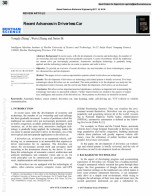

英语原文共 9 页
英文文献翻译
Recent Advances in Driverless Car(无人驾驶汽车最新进展)
Abstract(摘要):
Background: In recent years, with the development of economy and technology, the number of
car ownership and road mileage has been gradually increased. A series of problems which the traditional car cannot solve got increasingly prominent. Automotive intelligent technology is gradually being applied, and the technology makes the car easier to operate, and safer to drive.
Objective: To provide an overview of recent driverless cars and introduce its basic technologies, respective characteristics and developments.
Method: This paper reviews various representative patents related to driverless car technologies.
Results: The development of driverless car technology and related patents is briefly reviewed. Five basic technologies about driverless car are concluded. The main problems in its development are analyzed, the development trend is foreseen, and the current and future developments of driverless car are discussed.
Conclusion: Driverless car has important practical significance, and plays an important role in promoting the technology innovation in automobile industry. Further improvements are needed in the aspects of regulation, intelligence and security of the driverless car. More patents on driverless car should be invented.
背景:近年来,随着经济和技术的发展,汽车拥有量和道路里程逐渐增加。传统汽车无法解决的一系列问题日益突出。汽车智能技术正在逐步应用,该技术使汽车更易于操作,驾驶更安全。
目的:概述近期无人驾驶汽车,介绍其基本技术,各自的特点和发展。
方法:本文概述了与无人驾驶汽车技术相关的各种代表性技术。
结果:简要回顾了无人驾驶汽车技术及相关专利的发展。总结了无人驾驶汽车的五项基本技术。分析了其发展中存在的主要问题,预见了发展趋势,并对无人驾驶汽车的现状和未来发展进行了探讨。
结论:无人驾驶汽车具有重要的现实意义,对推动汽车工业技术创新具有重要作用。在无人驾驶汽车的调节,智能和安全方面需要进一步改进。应该发明更多关于无人驾驶汽车的专利。
Keywords: Automatic brakes, cruise control, driverless car, lane keeping, radar, self-driving car, V2V (vehicle to vehicle) communication.
关键词:自动刹车,巡航控制,无人驾驶汽车,车道保持,雷达,自动驾驶汽车,V2V(车辆对车辆)通讯
1. INTRODUCTION
In recent years, with the development of economy and technology, the number of car ownership and road mileage has been gradually increased. A series of problems which the
traditional car cannot solve got increasingly prominent, such as traffic congestion, accident, pollution and shortage of land resources, etc. at the same time, automotive intelligent technology is gradually being applied; the technology makes the car easier to operate and safer to drive. In the future, one of the most typical and most popular applications is driverless car.
A driverless car, as known as an unmanned vehicle, selfdriving car, or autonomous is an automobile that requires no driver intervention for its operation. The driverless car senses the environment around itself and navigates itself according to the destination chosen by the driver. It combines the technologies of automatic control, architecture and artificial intelligence and computer vision and so on. Its work principles can be summarized as: perception, judgment, implementation and interconnection.
The driverless cars are equipped with the technologies of radars, video cameras, sensors, computer vision, and GPS(Global Positioning System). They can visualize the environment around themselves. Driverless cars are growing in popularity and generating interest all of the world. According to National Highway Traffic Safety Administration (NHTSA), automotive automation is defined as the following five levels (Table 1) [1].
For example, in China and the United States, automatic vehicles have a huge demand. Especially in the big city with large population and traffic congestion, building automatic vehicle share platform will greatly improve vehicle efficiency, raise the utilization of public facilities and make
people#39;s travel more convenient.
In this paper, the development of driverless car technology and related patents is briefly reviewed, and the role of driverless car and its development trend are discussed.
- 引言
近年来,随着经济的发展而变化技术,汽车拥有量和道路里程已逐渐增加。其中的一系列问题传统汽车无法解决的越来越突出,例如交通拥堵,安全事故,污染和土地短缺资源等。同时,汽车智能技术正在逐步应用; 这项技术使得汽车更容易操作,更安全驾驶。在未来,其中最典型和最受欢迎的应用是无人驾驶汽车。
无人驾驶汽车,被称为无人驾驶汽车,无人驾驶汽车或自动驾驶汽车是一种不需要汽车司机干预其运作的汽车。无人驾驶汽车感知周围的环境并自行导航根据司机选择的目的地。它结合了自动控制,架构和技术人工智能和计算机视觉等。它的工作原则可归纳为:感知,判断,实施和互联。
无人驾驶汽车配备了技术雷达,摄像机,传感器,计算机视觉和GPS(全球定位系统)。 他们可以感知自己周围的环境。无人驾驶汽车受欢迎程度增长并引起全世界的兴趣。符合国家公路交通安全管理局(NHTSA),汽车自动化过程被定义为五个阶段。
例如,在中国和美国,自动车辆需求量巨大。特别是在大城市里人口众多,交通拥堵,建筑自动化车辆共享平台将大大提高车辆效率,提高公共设施的利用率人们的出行比较方便。
本文中,简要回顾了无人驾驶汽车技术及相关专利的发展及其作用,并讨论了无人驾驶汽车未来发展趋势。
Table 1. Five Levels of Automotive Automation.
|
Level 0 |
Driver assistance |
The driver controls the car at all time |
|
Level 1 |
Partial automation |
The car has one or more special automatic control functions |
|
Level 2 |
Conditional automation |
The car has at least two original control functions fused together. The driver needs to constantly monitor the system |
|
Level 3 |
High automation |
In some specific traffic conditions, the driver does not need to control the car. There is no need to constantly monitor the system |
|
Level 4 |
Full automation |
The system is fully auto-control the car |
表1:汽车自动化的五个阶段
|
阶段0 |
驾驶员辅助 |
始终由驾驶员控制汽车 |
|
阶段1 |
部分自动化 |
汽车车具有一个或多个特殊的自动控制功能 |
|
阶段2 |
条件自动化 |
汽车至少有两个融合在 |


